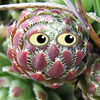Mali i Thatė
3 posters
Page 1 of 1
 Mali i Thatė
Mali i Thatė
Mali i Thatė is a mountain in Albania - a part of it lies in Macedonia and is named Galičica. Highest altitude of Mali i Thatė is 2287 m.
Wrong form of this geographical name is Mali hat / Mali Hat.
Mali i Thatė is a habitat of:
S. marmoreum subsp. marmoreum
S. ciliosum subsp. octopodes.
Wrong form of this geographical name is Mali hat / Mali Hat.
Mali i Thatė is a habitat of:
S. marmoreum subsp. marmoreum
S. ciliosum subsp. octopodes.

I'm the 1- Admin
- Number of plants : 2.000 Posts : 5336
Join date : 2008-06-14
Location : Ljubljana, Slovenia, European Union
 Re: Mali i Thatė
Re: Mali i Thatė
Photo of habitat: http://picasaweb.google.com/lh/photo/nfhB1q9SM8udtheoDxsjtA

I'm the 1- Admin
- Number of plants : 2.000 Posts : 5336
Join date : 2008-06-14
Location : Ljubljana, Slovenia, European Union
 Re: Mali i Thatė
Re: Mali i Thatė
I think, that S. octopodes does not grow there. Sempervivum ciliosum var. galicicum grows there.
 Re: Mali i Thatė
Re: Mali i Thatė
Here's how Peter J. Mitchell described plant from this locality in
The Sempervivum Society Journal Volume 1 (1970), No. 3:
"This form is smaller in all respects than the type plant and additionally, as can be seen from the plate, has plum red leaves. The rosettes are much more compact and the hairs from the leaf tins are not so long. It is also one of the better flowers of the genus, not being so top heavy as in other species. The flowers are yellow. The rosettes are produced on long slender stolons and it is here that it approaches S. octopodes otherwise it is quite distinct and cannot be confused with any other species."
Maybe that's the reason why someone claim S. octopodes also grow there!
The Sempervivum Society Journal Volume 1 (1970), No. 3:
"This form is smaller in all respects than the type plant and additionally, as can be seen from the plate, has plum red leaves. The rosettes are much more compact and the hairs from the leaf tins are not so long. It is also one of the better flowers of the genus, not being so top heavy as in other species. The flowers are yellow. The rosettes are produced on long slender stolons and it is here that it approaches S. octopodes otherwise it is quite distinct and cannot be confused with any other species."
Maybe that's the reason why someone claim S. octopodes also grow there!

I'm the 1- Admin
- Number of plants : 2.000 Posts : 5336
Join date : 2008-06-14
Location : Ljubljana, Slovenia, European Union
 Re: Mali i Thatė
Re: Mali i Thatė
This is how David T. Ford described S. ciliosum from Mali Hat in The Sempervivum Society Journal Volume 4 (1973), No. 4:
"An attractive little geographical form of S. ciliosum which is very popular and is something different from other Sempervivums. If grown well it will form quite firm balls which are attractive at all times of the year. It is very generous in producing offsets which soon form large clumps. Very easy to grow."

"An attractive little geographical form of S. ciliosum which is very popular and is something different from other Sempervivums. If grown well it will form quite firm balls which are attractive at all times of the year. It is very generous in producing offsets which soon form large clumps. Very easy to grow."

Last edited by Renata on Thu Jun 14, 2012 3:55 pm; edited 1 time in total

I'm the 1- Admin
- Number of plants : 2.000 Posts : 5336
Join date : 2008-06-14
Location : Ljubljana, Slovenia, European Union
 Re: Mali i Thatė
Re: Mali i Thatė
What a great idea, Jezour! Tell us more about this species at Mali i Thatė! Any photos?

I'm the 1- Admin
- Number of plants : 2.000 Posts : 5336
Join date : 2008-06-14
Location : Ljubljana, Slovenia, European Union
 Re: Mali i Thatė
Re: Mali i Thatė
I was not in Mali i Thatė mountains. But I would like to visit these mountains. I think, that Mali i Thatė mountains are very interestring. Does anyone know anything more about S. jakucsii?
 Re: Mali i Thatė
Re: Mali i Thatė
So, another question. Does anyone know something about S. jakucsii? I am asking before I will write more...
 Re: Mali i Thatė
Re: Mali i Thatė
Nothing more than what I found with Google: that it is regarded as a synonim of S. ciliosum ssp. octopodes. Of course, species and subspecies are just a concept, a way of organising biotic diversity - in our mind. Clearly, Mitchell was convinced that this plant is different from octopodes. The question is then if this was because he knew only a few clones of octopodes (and did not have a sufficient overview of the variation within this taxon), or if there is some real difference which sets this plant apart.
I feel that on one hand many taxa were described prematurely, but equally prematurely many are now discarded as synonims. Perhaps an alternative is to use these names as variety of clone names, untill fieldwork combined with DNA research tells otherwise.
(I am aware that I could state this in many threads on this forum, but like this I will get a message when you write more on this interesting plant, Jezour )
)
I feel that on one hand many taxa were described prematurely, but equally prematurely many are now discarded as synonims. Perhaps an alternative is to use these names as variety of clone names, untill fieldwork combined with DNA research tells otherwise.
(I am aware that I could state this in many threads on this forum, but like this I will get a message when you write more on this interesting plant, Jezour

illustrator- Golden Rosette

- Number of plants : 100+ Posts : 224
Join date : 2010-08-04
Location : Slovenia
 Re: Mali i Thatė
Re: Mali i Thatė
Sempervivum jakucsii was described by Pénzes in 1965. There was not much information about habitat - between Pojan and Podgorje in Mali i Thatė mountains, Albania.
Not enough information, isn't it? That was the reason, why I found something more about S. jakucsii. I got the original description and the picture of the herbary item. I want to thank the employees of the Museum in Budapest. They helped me with the research very much.
Mali i Thatė mountains are the continuation of Galičica. The mountains are created by limestone. There grow two species of the genus Sempervivum in Mali i Thatė mountains (maybe more, but I do not know about them now) - S. ciliosum var. galicicum and S. marmoreum. When I have seen the herbary item, I was very surprised. S. jakucsii is not the synonym for S. octopodes. It is a bigger plant of Sempervivum ciliosum var. galicicum.
There is one interestring thing. S. jakucsii was described earlier than S. ciliosum var. galicicum. S. jakucsii - 1965, S. ciliosum var. galicicum - 1978. Is not S. ciliosum var. galicicum the synonym for S. jakucsii??
Another interestring thing. You can read in many books, that S. jakucsii is the synonym for S. octopodes. I think, that it is nice example of copying. Many authors copy the information, althoug they do not know anything about it.
I am looking forward to your questions.
Not enough information, isn't it? That was the reason, why I found something more about S. jakucsii. I got the original description and the picture of the herbary item. I want to thank the employees of the Museum in Budapest. They helped me with the research very much.
Mali i Thatė mountains are the continuation of Galičica. The mountains are created by limestone. There grow two species of the genus Sempervivum in Mali i Thatė mountains (maybe more, but I do not know about them now) - S. ciliosum var. galicicum and S. marmoreum. When I have seen the herbary item, I was very surprised. S. jakucsii is not the synonym for S. octopodes. It is a bigger plant of Sempervivum ciliosum var. galicicum.
There is one interestring thing. S. jakucsii was described earlier than S. ciliosum var. galicicum. S. jakucsii - 1965, S. ciliosum var. galicicum - 1978. Is not S. ciliosum var. galicicum the synonym for S. jakucsii??
Another interestring thing. You can read in many books, that S. jakucsii is the synonym for S. octopodes. I think, that it is nice example of copying. Many authors copy the information, althoug they do not know anything about it.
I am looking forward to your questions.
Page 1 of 1
Permissions in this forum:
You cannot reply to topics in this forum